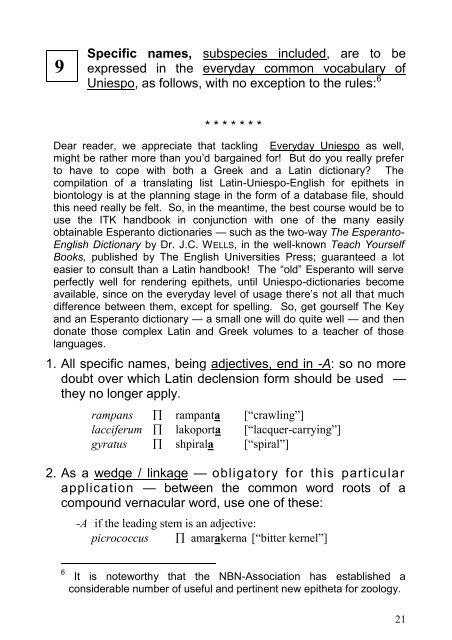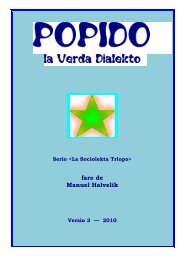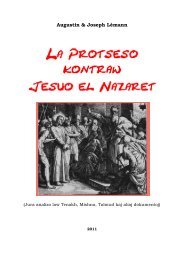the TRIMERAL SYSTEM in BIOLOGICAL TAXONOMY - universala ...
the TRIMERAL SYSTEM in BIOLOGICAL TAXONOMY - universala ...
the TRIMERAL SYSTEM in BIOLOGICAL TAXONOMY - universala ...
You also want an ePaper? Increase the reach of your titles
YUMPU automatically turns print PDFs into web optimized ePapers that Google loves.
9<br />
Specific names, subspecies <strong>in</strong>cluded, are to be<br />
expressed <strong>in</strong> <strong>the</strong> everyday common vocabulary of<br />
Uniespo, as follows, with no exception to <strong>the</strong> rules: 6<br />
* * * * * * *<br />
Dear reader, we appreciate that tackl<strong>in</strong>g Everyday Uniespo as well,<br />
might be ra<strong>the</strong>r more than you’d barga<strong>in</strong>ed for! But do you really prefer<br />
to have to cope with both a Greek and a Lat<strong>in</strong> dictionary? The<br />
compilation of a translat<strong>in</strong>g list Lat<strong>in</strong>-Uniespo-English for epi<strong>the</strong>ts <strong>in</strong><br />
biontology is at <strong>the</strong> plann<strong>in</strong>g stage <strong>in</strong> <strong>the</strong> form of a database file, should<br />
this need really be felt. So, <strong>in</strong> <strong>the</strong> meantime, <strong>the</strong> best course would be to<br />
use <strong>the</strong> ITK handbook <strong>in</strong> conjunction with one of <strong>the</strong> many easily<br />
obta<strong>in</strong>able Esperanto dictionaries — such as <strong>the</strong> two-way The Esperanto-<br />
English Dictionary by Dr. J.C. WELLS, <strong>in</strong> <strong>the</strong> well-known Teach Yourself<br />
Books, published by The English Universities Press; guaranteed a lot<br />
easier to consult than a Lat<strong>in</strong> handbook! The “old” Esperanto will serve<br />
perfectly well for render<strong>in</strong>g epi<strong>the</strong>ts, until Uniespo-dictionaries become<br />
available, s<strong>in</strong>ce on <strong>the</strong> everyday level of usage <strong>the</strong>re’s not all that much<br />
difference between <strong>the</strong>m, except for spell<strong>in</strong>g. So, get gourself The Key<br />
and an Esperanto dictionary — a small one will do quite well — and <strong>the</strong>n<br />
donate those complex Lat<strong>in</strong> and Greek volumes to a teacher of those<br />
languages.<br />
1. All specific names, be<strong>in</strong>g adjectives, end <strong>in</strong> -A: so no more<br />
doubt over which Lat<strong>in</strong> declension form should be used —<br />
<strong>the</strong>y no longer apply.<br />
rampans rampanta [“crawl<strong>in</strong>g”]<br />
lacciferum lakoporta [“lacquer-carry<strong>in</strong>g”]<br />
gyratus shpirala [“spiral”]<br />
2. As a wedge / l<strong>in</strong>kage — obligatory for this particular<br />
application — between <strong>the</strong> common word roots of a<br />
compound vernacular word, use one of <strong>the</strong>se:<br />
6<br />
-A if <strong>the</strong> lead<strong>in</strong>g stem is an adjective:<br />
picrococcus amarakerna [“bitter kernel”]<br />
It is noteworthy that <strong>the</strong> NBN-Association has established a<br />
considerable number of useful and pert<strong>in</strong>ent new epi<strong>the</strong>ta for zoology.<br />
21






